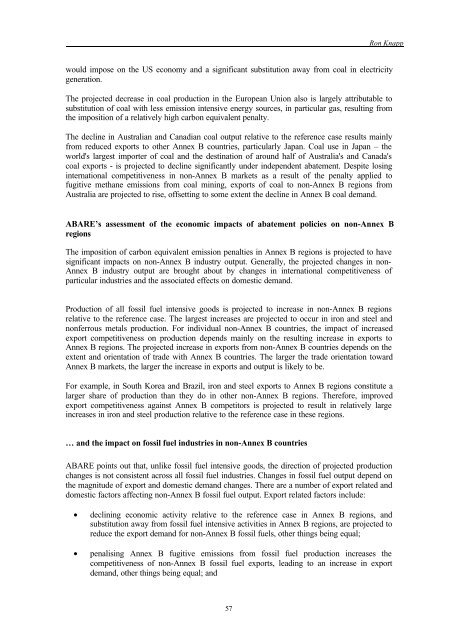sectoral economic costs and benefits of ghg mitigation - IPCC
sectoral economic costs and benefits of ghg mitigation - IPCC
sectoral economic costs and benefits of ghg mitigation - IPCC
You also want an ePaper? Increase the reach of your titles
YUMPU automatically turns print PDFs into web optimized ePapers that Google loves.
Ron Knapp<br />
would impose on the US economy <strong>and</strong> a significant substitution away from coal in electricity<br />
generation.<br />
The projected decrease in coal production in the European Union also is largely attributable to<br />
substitution <strong>of</strong> coal with less emission intensive energy sources, in particular gas, resulting from<br />
the imposition <strong>of</strong> a relatively high carbon equivalent penalty.<br />
The decline in Australian <strong>and</strong> Canadian coal output relative to the reference case results mainly<br />
from reduced exports to other Annex B countries, particularly Japan. Coal use in Japan – the<br />
world's largest importer <strong>of</strong> coal <strong>and</strong> the destination <strong>of</strong> around half <strong>of</strong> Australia's <strong>and</strong> Canada's<br />
coal exports - is projected to decline significantly under independent abatement. Despite losing<br />
international competitiveness in non-Annex B markets as a result <strong>of</strong> the penalty applied to<br />
fugitive methane emissions from coal mining, exports <strong>of</strong> coal to non-Annex B regions from<br />
Australia are projected to rise, <strong>of</strong>fsetting to some extent the decline in Annex B coal dem<strong>and</strong>.<br />
ABARE’s assessment <strong>of</strong> the <strong>economic</strong> impacts <strong>of</strong> abatement policies on non-Annex B<br />
regions<br />
The imposition <strong>of</strong> carbon equivalent emission penalties in Annex B regions is projected to have<br />
significant impacts on non-Annex B industry output. Generally, the projected changes in non-<br />
Annex B industry output are brought about by changes in international competitiveness <strong>of</strong><br />
particular industries <strong>and</strong> the associated effects on domestic dem<strong>and</strong>.<br />
Production <strong>of</strong> all fossil fuel intensive goods is projected to increase in non-Annex B regions<br />
relative to the reference case. The largest increases are projected to occur in iron <strong>and</strong> steel <strong>and</strong><br />
nonferrous metals production. For individual non-Annex B countries, the impact <strong>of</strong> increased<br />
export competitiveness on production depends mainly on the resulting increase in exports to<br />
Annex B regions. The projected increase in exports from non-Annex B countries depends on the<br />
extent <strong>and</strong> orientation <strong>of</strong> trade with Annex B countries. The larger the trade orientation toward<br />
Annex B markets, the larger the increase in exports <strong>and</strong> output is likely to be.<br />
For example, in South Korea <strong>and</strong> Brazil, iron <strong>and</strong> steel exports to Annex B regions constitute a<br />
larger share <strong>of</strong> production than they do in other non-Annex B regions. Therefore, improved<br />
export competitiveness against Annex B competitors is projected to result in relatively large<br />
increases in iron <strong>and</strong> steel production relative to the reference case in these regions.<br />
… <strong>and</strong> the impact on fossil fuel industries in non-Annex B countries<br />
ABARE points out that, unlike fossil fuel intensive goods, the direction <strong>of</strong> projected production<br />
changes is not consistent across all fossil fuel industries. Changes in fossil fuel output depend on<br />
the magnitude <strong>of</strong> export <strong>and</strong> domestic dem<strong>and</strong> changes. There are a number <strong>of</strong> export related <strong>and</strong><br />
domestic factors affecting non-Annex B fossil fuel output. Export related factors include:<br />
• declining <strong>economic</strong> activity relative to the reference case in Annex B regions, <strong>and</strong><br />
substitution away from fossil fuel intensive activities in Annex B regions, are projected to<br />
reduce the export dem<strong>and</strong> for non-Annex B fossil fuels, other things being equal;<br />
• penalising Annex B fugitive emissions from fossil fuel production increases the<br />
competitiveness <strong>of</strong> non-Annex B fossil fuel exports, leading to an increase in export<br />
dem<strong>and</strong>, other things being equal; <strong>and</strong><br />
57
















